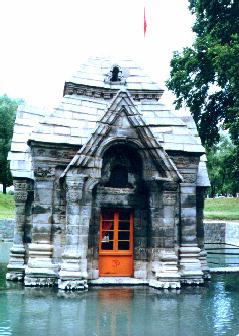Historical
Places

Pandrethan
Situated
near Srinagar, Pandrethan is remarkable for a very
old and interesting Hindu temple, standing in the
middle of the tank, about 50 yards from the river
bank. The tank is about 40 yards square. The temple
is 18 feet square with a projecting portico on each
side, and displays in a confused exuberance of
decoration, more especially the repetition of
pediment within pediment and trefoil within trefoil,
clear indications of having been built at a later
date than other existing ruins. It is probably the
most modern example of the true Kashmiri style
extant. It was erected during the reign of king
Partha, who governed Kashmir from AD 921 to 931, by
his prime minister Meru, who dedicated it to
Mahadeva under the title of Meru Vardhama Swami.
There are in the neighbourhood some few fragmentary
remains, consisting of two large lingams, one 6 feet
high, erect and entire, the other broken into three
pieces, the lower part polygonal, the upper round
with conical top, which together made up a height of
16 feet. Near these, which are seperated from each
other by a short interval, is a huge mass of stone,
being feet and legs as high as the knees of a
colossal seated figure, probably a Buddhist image.
At some little distance beyond this, an isolated
crag has been cut, as it stood, into some sculptured
f.mp3, apparently a Chaumukhi, i.e. a square pillar
with a figure on each side. Baron Hugel calls the
Pandrethan edifice a 'Buddhist temple' and
states that there are some well preserved Buddhist
figures in the interior. But he is doubly mistaken,
for the temple was dedicated to Mahadeva and the
figures inside have no connection with Buddhism.

Pandrethan (near Srinagar). One of the few
temples of Kashmir with roof intact.
Although miniature in size, it is ornate with
structural symmetry.
10th century era.
Islamic
Monuments
Pathar
Masjid: This mosque opposite Shah Hamdan mosque
across the Jhelum in Srinagar, is the largest
surviving Mughal structure in Kashmir. Built in
local grey limestone, the facade consists of nine
arches, remarkable for their horizontal
construction. Built in 1623 AD by Nur Jehan, the
Pathar Masjid was, however, never used for prayers.

Pather Masjid, the
valley's only unconsecrated mosque.
Shah
Hamdan Mosque: The medievel wooden style
of Kashmir’s Muslim architecture is best typified
in the Khanqah mosque of Shah Hamdan in Srinagar
between third and fourth bridge on the right bank of
river Jhelum.Sultan Sikandar built the mosque in
1395 AD, to commemorate the the visit of Mir Sayyid
Ali Hamdani, popularly known as Shah Hamdan. Twice
destroyed by fire, the structure as it stands now,
with cloisters added later, was rebuilt by Abul
Barkat Khan in 1732 AD. Some of the doors and
windows in the mosque are exquisite specimen of the
Kashmir wood carver’s art at its best. The
pyramidal roof culminates in a graceful steeple,
rising 38 meters from the ground.

The beautifully inlaid
doorway to Shah Hamdan's shrine.
Jama
Masjid: The most ‘architectural’ structure
in the wooden style of Kashmir is the Jama Masjid of
Srinagar. Buily by Sultan Sikandar in 1389 AD and
enlarged by his son, Sultan Zain-ul-Abidin, it was
rebuilt (after fires) and repaired by several kings
including Jehangir and Aurangzeb. The mosque, a huge
structure containing all the essential components of
the Kashmir type of wooden building, is a
quadrangle, roughly square in shape, its northern
and southers sides measuring 107 meters. Four minars,
one in the middle of each side, are covered by a
series of pyramidal roofs. The compound is divided
by two broad paths, planned after the pattern of a
f.mp3er Mughal garden.

The simple beauty of Jama
Masjid.
| 